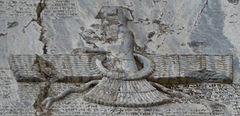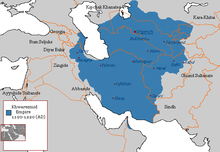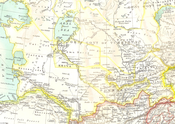Khwarazm
| History of Greater Iran |
|---|
Khwarazm /kwəˈrɛzəm/, or Chorasmia /kəˈræzmiə/ (Persian: خوارزم, Xvârazm) is a large oasis region on the Amu Darya river delta in western Central Asia, bordered on the north by the (former) Aral Sea, on the east by the Kyzylkum desert, on the south by the Karakum desert, and on the west by the Ustyurt Plateau. It was the center of the Iranian[1] Khwarazmian civilization, and a series of kingdoms such as the Persian Empire, whose capitals were (among others) Kath, Gurganj (the modern Köneürgenç) and – from the 16th century on – Khiva. Today Khwarazm belongs partly to Uzbekistan, partly to Kazakhstan and partly to Turkmenistan.
Contents
Names and etymology
Names
Khwarazm has been known also as Chorasmia, Khaurism,[2] Khwarezmia, Khwarizm,
Khwarazm, Khorezm, Khoresm, Khorasam, Kharazm, Harezm, Horezm, and Chorezm.[3]
In Avestan the name is Xvairizem; in Old Persian Huwarazmish; in Modern Persian: خوارزم Xvārazm; in Arabic: خُـوَارِزْم Xuwārizm; in Old Chinese *qʰaljɯʔmriɡ (呼似密); in Modern Chinese Huālázǐmó (花剌子模 / Xiao'erjing: خٗوَلاذِموْ); in Tajik: Хоразм, Xorazm, خارَزم; in Kazakh: Хорезм (Xorezm), حورەزم; in Uzbek: Xorazm, Хоразм, خورەزم; in Turkmen: Horezm, Хорезм, خوْرِزم; in Turkish: Harezm; in Greek language Χορασμία (Chorasmía) and Χορασίμα (Chorasíma) by Herodotus.
Etymology
The Arab geographer Yaqut al-Hamawi in his Muʿǧam al-buldan wrote that the name was a Persian compound of khwar (خوار), and razm (رزم), referring to the abundance of cooked fish as a main diet of the peoples of this area.[4]
C.E. Bosworth, however, believed the Persian name to be made up of xor (خور "the sun") and zam (زم "earth, land"), designating "the land from which the sun rises",[5] although a similar etymology is also given for Khurasan. Another view is that the Iranian compound stands for "lowland" from kh(w)ar "low" and zam "land.".[3] Khwarazm is indeed the lowest region in Central Asia (except for the Caspian Sea to the far west), located on the delta of the Amu Darya on the southern shores of the Aral Sea. Various forms of khwar/khar/khor/hor are commonly used also in the Persian Gulf to stand for tidal flats, marshland, or tidal bays (e.g., Khor Musa, Khor Abdallah, Hor al-Azim, Hor al-Himar, etc.)
The name also appears in Achaemenid inscriptions as Huvarazmish, which is declared to be part of the Persian Empire.
Some of the early scholars believed Khwarazm to be what ancient Avestic texts refer to as Airyanem Vaejah (Ariyaneh Waeje; later Middle Persian Iran vij).[6] These sources claim that Old Urgench, which was the capital of ancient Khwarazm for many years, was actually Ourva, the eighth land of Ahura Mazda mentioned in the Pahlavi text of Vendidad.[7] However, Michael Witzel, a researcher in early Indo-European history, believes that Airyanem Vaejah was located in what is now Afghanistan, the northern areas of which were a part of ancient Khwarazm and Greater Khorasan.[8] Others, however, disagree. University of Hawaii historian Elton L. Daniel believes Khwarazm to be the "most likely locale" corresponding to the original home of the Avestan people, and Dehkhoda calls Khwarazm "the cradle of the Aryan tribe" (مهد قوم آریا).[9]
Legendary history
Al-Biruni (973–1048), a native speaker of Chorasmian (an Iranian language),[10][11][12] says that the land belonging to the mythical king Afrasiab was first colonised 980 years before Alexander the Great (thus c. 1292 B.C., well before the Seleucid era) when the hero of the Iranian epic Siyavash came to Khwarazm; his son Kay Khusraw came to the throne 92 years later, in 1200 B.C. Al-Biruni starts giving names only with the Afrighidline of Khwarazmshahs, having placed the ascension of Afrighids in 616 of the Seleucid era, i.e. in 305 A.D.
Early people
Like Soghdiana, Khwarazm was an expansion of the BMAC culture during the Bronze Age which later fused with Indo-Iranians during their migrations around 1000 BC. Early Iron Age states arose from this cultural exchange. List of successive cultures in Khwarazm region 3000–500 BC:[13]
- Keltiminar Culture c. 3000 BC
- Suyargan Culture c 2000 BC
- Tazabag’yab Culture c. 1500 BC
- Amirabad Culture c 1000 BC
- Saka c. 500 BC
During the final Saka phase, there were about 400 settlements in Khwarezm.[14] Ruled by the native Afrighid Dynasty. It was at this point that Khwarezm entered the historical record with the Achamenid expansion.[citation needed]
Khwarezmian language and culture
This article may require cleanup to meet Wikipedia's quality standards. The specific problem is: Khwarezmian = Chorasmian (July 2012) (Learn how and when to remove this template message) |
An East Iranian language, known as Khwarezmian language, was spoken in Khwarezm proper (i.e., the lower Amu Darya region) until soon after the Mongol invasion, when it was replaced by Turkic languages.[15][16][17][18] It was closely related to Sogdian. Other than the astronomical terms used by the native Iranian Chorasmian speaker Al-Biruni,[12] our other sources of Khwarezmian include Zamakhshari's Arabic-Persian–Khwarezmian dictionary and several legal texts that use Khwarezmian terms to explain certain legal concepts.
In the very early part of its history, the inhabitants of the area were from Iranian[19][20] stock and they spoke an Eastern Iranian language called Khwarezmian. The famous scientist Al-Biruni, a Khwarezm native, in his Athar ul-Baqiyah,[21] specifically verifies the Iranian origins of Khwarezmians when he wrote (in Arabic):
The area of Khwarezm was under Afrighid and then Samanid control until the 10th century before it was conquered by the Ghaznavids. The Iranian Chorasmian language and culture felt the pressure of Turkic infiltration from northern Khwarezm southwards, leading to the disappearance of the original Iranian character[12] of the province and its complete Turkicisation today, but Khwarezmian speech[12] probably lasted in upper Khwarezm, the region round Hazarasp, till the end of the 8th/14th century.[12]
The Iranian Chorasmian language survived for several centuries after Islam until the Turkification of the region, and so must some at least of the culture and lore of ancient Khwarezm, for it is hard to see the commanding figure of Al-Biruni, a repository of so much knowledge, appearing in a cultural vacuum.[12]
Achaemenid, Parthian and Sassanid era
Sometime before the Achaemenid king Cyrus the Great's death in 530 BC, he had conquered Khwarezm. While he was dying, he appointed his son Smerdis/Bardiya as the governor of the region, along with Bactriana, Carmania, and the other eastern provinces of the empire.[22] And the Persian poet Ferdowsi mentions Persian cities like Afrasiab and Chach in abundance in his epic Shahnama.
When the king of Khwarezm offered friendship to Alexander the Great in 328 BC, Alexander's Greek and Roman biographers imagined the nomad king of a desert waste, but 20th-century Russian archeologists revealed the region as a stable and centralized kingdom, a land of agriculture to the east of the Aral Sea, surrounded by the nomads of Central Asia, protected by its army of mailed horsemen, in the most powerful kingdom northwest of the Amu Darya (the Oxus River of antiquity). The king's emissary offered to lead Alexander's armies against his own enemies, west over the Caspian towards the Black Sea (e.g. Kingdom of Iberia and Colchis). Alexander politely refused.
Although largely independent during the Seleucid, Bactrian and Arsacid dynasties, it is known that Khwarezm and neighboring Bactriana were part of the Sassanid empire during the time of Bahram II. Yaqut al-Hamawi verifies that Khwarezm was a regional capital of the Sassanid empire. When speaking of the pre-Islamic "khosrau of Khwarezm" (خسرو خوارزم), the Islamic "amirof Khwarezm" (امیر خوارزم), or even the Khwarezmid Empire, sources such as Al-Biruni and Ibn Khordadbeh and others clearly refer to Khwarezm as being part of the Iranian (Persian) empire.[23] The fact that Pahlavi script which was used by the Persian bureaucracy alongside Old Persian, passed into use in Khwarezmia where it served as the first local alphabet about the AD 2nd century, as well as evidence that Khwarezm-Shahs such as ʿAlā al-Dīn Tekish (1172–1200) issued all their orders (both administrative and public) in Persian language,[24]corroborates Al-Biruni's claims. It was also a vassal kingdom during periods of Kushans, Hephthalites and Gokturks power before the coming of the Arabs.
Afrighids
The Afrighids (آفریغیان-آل آفریغ) were a native Chorasmian (i.g. Iranian) [10][26][27] dynasty which ruled over the kingdom of Khwarezm (according to Al-Biruni) from 305 until 995 A.D. Sometimes it was under Sassanid control.
In 712 Khwarezm was conquered by the Arab Umayyads. It thus came vaguely under Muslim suzerainty, but it was not until the end of the 8th century or the beginning of the 9th century that an Afrighid Shah was first converted to Islam appearing with the popular convert’s name of ʿAbdallah (slave of God). In the course of the 10th century, when some geographers such as Istakhri in his Al-Masalik wa-l-mamalik mention Khwarezm as part of Khorasan and Transoxiania, the local family of the Ma'munids who were based in Gurganj, on the left bank of the Amu Darya grew in economic and political importance due to trade caravans. In 995, they violently overthrew the Afrighids of Kath and themselves assumed the traditional title of Khwarazm-Shah. Briefly, the area was under Samanid suzerainty, before it passed to Mahmud of Ghazna in 1017. From then on, Turco-Mongolian invasions and long rule by Turco-Mongol dynasties supplanted the Iranian character of the region[27] although the title of Khwarezm-Shah was maintained well up to the 13th century.[27]
Khwarezmid Empire
The Khwarezmid Empire was founded in the 12th century. It became a vassal of the Kara-Khitan Khanate after Yelü Dashi won the Battle of Qatwan (1141) against a Seljuk army commanded by Sanjar.[28] Kara-Khitan suzerainty weakened later. The Khwarezmid Empire ruled over all of Persia in the early 13th century under Shah ʿAlāʾ al-Dīn Muhammad II(1200–1220). From 1218 to 1220, Genghis Khan conquered Central Asia including the Kara-Khitan Khanate, thus ending the Khwarezmid Empire. Sultan Muhammad died after retreating from the Mongols near the Caspian Sea, while his son Jalal ad-Din, after being defeated by Genghis Khan at the Battle of Indus, sought refuge with the Delhi Sultanate, and was later assassinated after various attempts to defeat the Mongols and the Seljuks.
Modern age
The region of Khwarezm was split between the White Horde and Jagatai Khanate, and its rebuilt capital Gurganj (modern Kunya Urgench, "Old Gorganj" as against the modern city of Urgench some distance away ) again became one of the largest and most important trading centers in Central Asia. In the mid-14th century Khwarezm gained independence from the Golden Horde under the Sufid dynasty. However, Timur regarded Khwarezm as a rival to Samarkand, and over the course of 5 campaigns, he destroyed Urganch completely in 1388. This together with a shift in the course of the Amu-Darya caused the center of Khwarezm to shift to Khiva, which became in the 16th century the capital of the Khanate of Khiva, ruled over by the dynasty of the Arabshahids.
The rumors of gold on the banks of the Amu Darya during the reign of Russia's Peter the Great, together with the desire of the Russian Empire to open a trade route to the Indus (modern day Pakistan), prompted an armed trade expedition to the region, led by Prince Alexander Bekovich-Cherkassky, which was repelled by Khiva.
It was under Tsars Alexander II and Alexander III that serious efforts to annex the region started. one of the main pretexts to Russian military expeditions to Khiva was to free Russian slaves in the khanate and to prevent future slave capture and trade.
Early in The Great Game, Russian interests in the region collided with those of the British Empire in the First Anglo-Afghan War in 1839.
The Khanate of Khiva was gradually reduced in size from Russian expansion in Turkestan (including Khwarezm) and, in 1873, a peace treaty was signed that established Khiva as a quasi-independent Russian protectorate.
After the Bolshevik seizure of power in the October Revolution, a short-lived Khorezm People’s Soviet Republic (later the Khorezm SSR) was created out of the territory of the old Khanate of Khiva, before in 1924 it was finally incorporated into the Soviet Union, with the former Khanate divided between the new Turkmen SSR, Uzbek SSR and Karakalpakstan ASSR (initially part of Kazakh ASSR as Karakalpak Oblast).
The larger historical area of Khwarezm is further divided. Northern Khwarezm became the Uzbek SSR, and in 1925 the western part became the Turkmen SSR. Also, in 1936 northwestern part became Kazakh SSR. Following the collapse of the Soviet Union in 1991, these became Uzbekistan, Turkmenistan and Kazakhstan respectively. Many of the ancient Khwarezmian towns are situated currently in Xorazm Province, Uzbekistan.
Today, the area that was Khwarezm has a mixed population of Uzbeks, Karakalpaks, Turkmens, Tajiks, Tatars, and Kazakhs.[citation needed]
In Persian literature
Khwarezm and her cities appear in Persian literature in abundance, in both prose and poetry. Dehkhoda for example defines the name Bukhara itself as "full of knowledge", referring to the fact that in antiquity, Bukhara was a scientific and scholarship powerhouse. Rumi verifies this when he praises the city as such:
Other examples illustrate the eminent status of Khwarezmid and Transoxianian cities in Persian literature in the past 1500 years:
Yaqut al-Hamawi, who visited Khwarezm and its capital in 1219, wrote: "I have never seen a city more wealthy and beautiful than Gurganj". The city, however, was destroyed during several invasions, in particular when the Mongol army broke the dams of the Amu Darya which flooded the city. He reports that for every Mongol soldier, four inhabitants of Gurganj were killed. Najmeddin Kubra, the great Sufi master, was among the casualties. The Mongol army that devastated Gurganj was estimated to have been near 80,000 soldiers. The verse below refers to an early previous calamity that fell upon the region:
Nevertheless, the beauty and fame of Bukhara and Samarqand are well known in Persian literature. The following famous cosmopolitan ode perhaps best provides a notable example of this:
Legend has it that Tamerlane sent for Hafiz regarding this verse and asked angrily: "Are you he who was so bold as to offer my two great cities Samarkand and Bukhara for the mole on thy mistress's cheek?" Hafiz then replied, "Yes, sire, and it is by such acts of generosity that I have brought myself to such a state of destitution that I have now to solicit your bounty." Tamerlane is written to have been so pleased at his ready wit that he dismissed the poet with a handsome present.
Notable people
The following either hail from Khwarezm, or lived and are buried there:
- Zoroaster (aka Zarathustra), prophet and founder of the religion of Zoroastrianism
- Al-Biruni, outstanding scholar
- Ma'mun II, Khwarezm Shah and founder of an academy
- Najm al-Din Kubra, Sufi mystic
- Rashid al-Din Vatvat, panegyrist and epistolographer
- Fakhr al-Din Razi
- Ala al-Din Atsiz, Khwarezm Shah
- Ala al-Din Muhammad, Khwarezm Shah
- Jalal ad-Din Menguberdi, Khwarezm Shah
- Abu l-Hasan Sa'eedeh ibn Sa'deh, commentary writer on the writings of Sibawayh.
- Abaaq al-Khwarazmi
- Muhammad ibn Musa al-Khwarizmi, mathematician (for whom the term algorithm is named.)
- Muhammad ibn Ahmad al-Khwarizmi, 10th century encyclopedist who wrote Mafatih al-'Ulum (“Key to the Sciences”).
- Zamakhshari, scholar
- Qutb al-zaman Muhammad ibn Abu-Tahir Marvazi, philosopher
- Al-Marwazi, astronomer
- Mahmud Yalavach, ambassador and governor of Mavaraunnahr (1224–1238)
- Abu l-Ghazi Bahadur, Khan and historian
- Ras Tarkhan, a mercenary leader of the Khazars
See also
'호라즘·교탄·타림분지' 카테고리의 다른 글
| <펌> 타클라마칸 사막 (0) | 2019.02.03 |
|---|---|
| <펌> Kindom of Khotan (0) | 2019.02.03 |
| <펌>Greater Khorasan (0) | 2019.02.03 |
| <펌>Transoxiana (0) | 2019.02.03 |
| <펌> Orchon (0) | 2019.02.03 |








